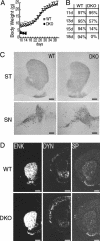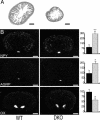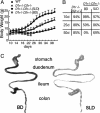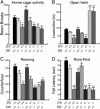Simultaneous absence of dopamine D1 and D2 receptor-mediated signaling is lethal in mice
- PMID: 15272078
- PMCID: PMC509223
- DOI: 10.1073/pnas.0402028101
Simultaneous absence of dopamine D1 and D2 receptor-mediated signaling is lethal in mice
Abstract
Dopamine (DA) controls a wide variety of physiological functions in the central nervous system as well as in the neuroendocrine and gastrointestinal systems. DA signaling is mediated by five cloned receptors named D1-D5. Knockout mouse models for the five receptors have been generated, and, albeit impaired for some important DA-mediated functions, they are viable and can reproduce. D1 and D2 receptors are the most abundant and widely expressed DA receptors. Cooperative/synergistic effects mediated by these receptors have been suggested, in particular, in the control of motor behaviors. To analyze the extent of such interrelationship, we have generated double D1/D2 receptor mutants. Interestingly, in contrast to single knockouts, we found that concurrent ablation of the D1 and D2 receptors is lethal during the second or third week after birth. This dramatic phenotype is likely to be related to altered feeding behavior and dysfunction of the gastrointestinal system, especially because major anatomical changes were not identified in the brain. Similarly, in the absence of functional D1, heterozygous D2 mutants (D1r(-/-);D2r(+/-)) showed severe growth retardation and did not survive their postweaning period. The analysis of motor behavior in D1r/D2r compound mutants showed that loss of D2-mediated functions reduces motor abilities, whereas the effect of D1r ablation on locomotion strongly depends on the experimental paradigms used. These studies highlight the interrelationship between D1 and D2 receptor-mediated control of motor activity, food intake, and gastrointestinal functions, which has been elusive in the single-gene ablation studies.
Figures





Similar articles
-
Whole-Brain Mapping of Direct Inputs to Dopamine D1 and D2 Receptor-Expressing Medium Spiny Neurons in the Posterior Dorsomedial Striatum.eNeuro. 2021 Jan 22;8(1):ENEURO.0348-20.2020. doi: 10.1523/ENEURO.0348-20.2020. Print 2021 Jan-Feb. eNeuro. 2021. PMID: 33380525 Free PMC article.
-
Distinct Roles of GluA2-lacking AMPA Receptor Expression in Dopamine D1 or D2 Receptor Neurons in Animal Behavior.Neuroscience. 2019 Feb 1;398:102-112. doi: 10.1016/j.neuroscience.2018.12.002. Epub 2018 Dec 8. Neuroscience. 2019. PMID: 30537522
-
Distinct Roles for Prefrontal Dopamine D1 and D2 Neurons in Social Hierarchy.J Neurosci. 2022 Jan 12;42(2):313-324. doi: 10.1523/JNEUROSCI.0741-21.2021. Epub 2021 Nov 29. J Neurosci. 2022. PMID: 34844989 Free PMC article.
-
Heteromerization of dopamine D2 receptors with dopamine D1 or D5 receptors generates intracellular calcium signaling by different mechanisms.Curr Opin Pharmacol. 2010 Feb;10(1):93-9. doi: 10.1016/j.coph.2009.09.011. Epub 2009 Nov 10. Curr Opin Pharmacol. 2010. PMID: 19897420 Free PMC article. Review.
-
Dopamine D1 receptors, regulation of gene expression in the brain, and neurodegeneration.CNS Neurol Disord Drug Targets. 2010 Nov;9(5):526-38. doi: 10.2174/187152710793361496. CNS Neurol Disord Drug Targets. 2010. PMID: 20632973 Free PMC article. Review.
Cited by
-
Dopamine, by acting through its D2 receptor, inhibits insulin-like growth factor-I (IGF-I)-induced gastric cancer cell proliferation via up-regulation of Krüppel-like factor 4 through down-regulation of IGF-IR and AKT phosphorylation.Am J Pathol. 2010 Dec;177(6):2701-7. doi: 10.2353/ajpath.2010.100617. Epub 2010 Nov 12. Am J Pathol. 2010. PMID: 21075859 Free PMC article.
-
Dopamine D1 + D3 receptor density may correlate with parkinson disease clinical features.Ann Clin Transl Neurol. 2021 Jan;8(1):224-237. doi: 10.1002/acn3.51274. Epub 2020 Dec 21. Ann Clin Transl Neurol. 2021. PMID: 33348472 Free PMC article.
-
Role of nuclear factor erythroid 2-related factor 2 in the oxidative stress-dependent hypertension associated with the depletion of DJ-1.Hypertension. 2015 Jun;65(6):1251-7. doi: 10.1161/HYPERTENSIONAHA.114.04525. Epub 2015 Apr 20. Hypertension. 2015. PMID: 25895590 Free PMC article.
-
Effect of Restricted Feeding on Metabolic Health and Sleep-Wake Rhythms in Aging Mice.Front Neurosci. 2021 Sep 7;15:745227. doi: 10.3389/fnins.2021.745227. eCollection 2021. Front Neurosci. 2021. PMID: 34557073 Free PMC article.
-
Dopamine signaling in the dorsal striatum is essential for motivated behaviors: lessons from dopamine-deficient mice.Ann N Y Acad Sci. 2008;1129:35-46. doi: 10.1196/annals.1417.003. Ann N Y Acad Sci. 2008. PMID: 18591467 Free PMC article. Review.
References
-
- Tan, S., Hermann, B. & Borrelli, E. (2003) Int. Rev. Neurobiol. 54, 145-197. - PubMed
-
- Xu, M., Moratalla, R., Gold, L. H., Hiroi, N., Koob, G. F., Graybiel, A. M. & Tonegawa, S. (1994) Cell 79, 729-742. - PubMed
-
- Baik, J. H., Picetti, R., Saiardi, A., Thiriet, G., Dierich, A., Depaulis, A., Le Meur, M. & Borrelli, E. (1995) Nature 377, 424-428. - PubMed
-
- Kelly, M. A., Rubinstein, M., Asa, S. L., Zhang, G., Saez, C., Bunzow, J. R., Allen, R. G., Hnasko, R., Ben-Jonathan, N., Grandy, D. K. & Low, M. J. (1997) Neuron 19, 103-113. - PubMed
Publication types
MeSH terms
Substances
LinkOut - more resources
Full Text Sources
Molecular Biology Databases

